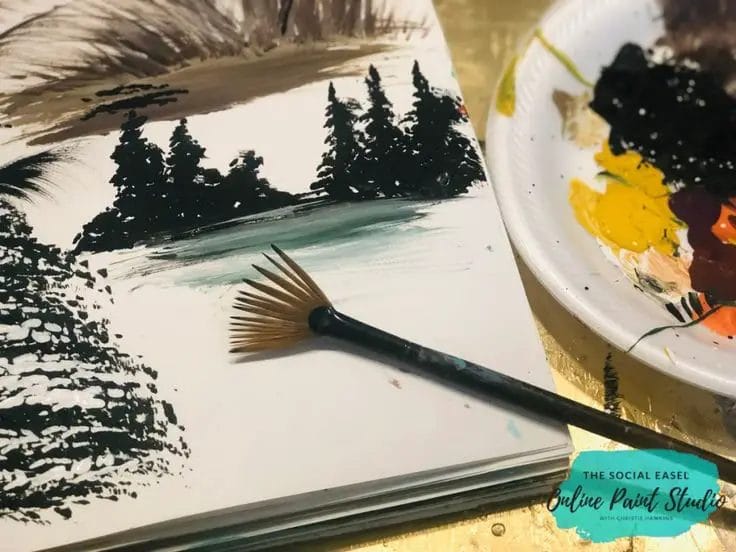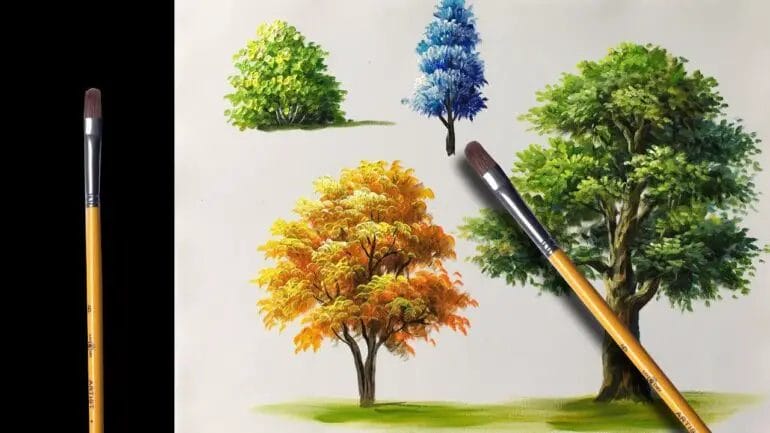A fan brush is a versatile tool used in acrylic painting. Its unique shape, resembling a fan, allows artists to create a wide array of effects and textures. When loaded with paint, the fan brush can be used to create soft and feathery strokes, ideal for depicting foliage, grass, or even the texture of clouds. This brush is also perfect for blending and creating subtle gradations, making it a must-have for acrylic painters looking to add dimension and depth to their artwork.

Adding Texture and Foliage: Techniques for Realistic Acrylic Artwork
When it comes to creating realistic acrylic artwork, adding texture and foliage can bring your paintings to life. One versatile tool that can help you achieve this is a fan brush. In this section, we will explore the versatility of a fan brush and learn techniques for creating realistic textures and foliage in your acrylic artwork.
The Versatility of a Fan Brush
A fan brush is a unique tool with a distinctive shape that resembles a fan. Its bristles are spread out, allowing for a variety of brushstrokes and effects. Here are some ways you can use a fan brush to add texture and foliage to your acrylic paintings:
- Drybrushing: This technique involves using a fan brush with only a small amount of paint to create a dry, textured effect. Lightly drag the brush across the surface to create wispy strokes, perfect for adding texture to tree branches or grass.
- Flicking: By pressing the fan brush against the canvas and quickly flicking your wrist, you can create scattered marks that resemble foliage or flowers. Experiment with different colors and brush sizes to achieve a realistic effect.
- Blending: The shape of the fan brush allows for seamless blending of colors. Apply two or more colors to the brush and gently stroke them onto the canvas to create smooth transitions, particularly useful when painting foliage or clouds.
- Feathering: To create delicate, feathery textures, lightly stroke the fan brush across the surface. This technique works well for adding details to animal fur or bird feathers.
Techniques for Realistic Textures and Foliage
Now that we understand the versatility of the fan brush, let’s explore some techniques for creating realistic textures and foliage in your acrylic artwork:
- Layering: Building layers is key to achieving depth and realism in your paintings. Start with a base layer of color and gradually add more texture and detail with subsequent layers. Use the fan brush to add foliage by lightly tapping it against the canvas, creating clusters of leaves or grass.
- Directional Strokes: Pay attention to the direction of your brushstrokes to create a sense of movement and realism. For foliage, use the fan brush to sweep the bristles in different directions, mimicking the natural flow of leaves or branches.
- Highlighting and Shadows: To add depth and dimension to your foliage, use different shades of green and apply highlights and shadows. Use the fan brush to gently dab lighter or darker colors onto the leaves to create a realistic three-dimensional effect.
- Adding Details: Once you have established the basic structure of your foliage, you can enhance the realism by adding fine details. Use a smaller fan brush or a different brush type to paint individual strands of grass, tiny flowers, or intricate patterns in tree bark.
Conclusion
In summary, the fan brush is a versatile tool that can help you add texture and foliage to your acrylic artwork. By exploring different techniques such as drybrushing, flicking, blending, and feathering, you can create realistic textures and foliage in your paintings. Remember to layer your colors, pay attention to directional strokes, add highlights and shadows, and add fine details to enhance the realism even further. With practice and experimentation, you can master the art of adding texture and foliage to elevate your acrylic artwork to new heights.

Painting Clouds and Skies: Unleash the Potential of a Fan Brush
When it comes to creating stunning cloud formations and atmospheric skies in your acrylic paintings, the fan brush is a versatile tool that can help you unleash your creativity. With its unique shape and bristle arrangement, the fan brush allows you to achieve a range of effects, from wispy clouds to dramatic stormy skies. In this section, we will explore different techniques and tips for painting clouds and skies using a fan brush.
1. Choosing the Right Fan Brush
Before diving into the painting process, it’s important to select the right fan brush for the task at hand. Fan brushes come in various sizes and bristle types, so consider the effect you want to achieve and the size of your canvas when choosing a brush. A larger fan brush is ideal for painting expansive skies, while a smaller brush is suitable for adding details to clouds. Additionally, synthetic bristles are better suited for acrylic paints as they are more durable.
2. Creating Cloud Formations
Clouds are an integral part of a captivating sky, and the fan brush can help you create realistic and expressive cloud formations. Here’s how:
- Load your fan brush with a mix of white paint and a touch of blue or gray to give your clouds depth and dimension.
- Hold the brush at a slight angle and gently press it onto the canvas, using a sweeping motion to create the basic shape of a cloud.
- Vary the pressure and direction of your brushstrokes to add texture and form to the clouds. Lighter strokes will create softer, fluffy clouds, while heavier strokes will result in more defined edges.
- For a more layered and realistic look, switch to a smaller fan brush and add highlights and shadows to your clouds. Use a lighter shade for highlights and a darker shade for shadows, blending them gently with the existing brushstrokes.
3. Painting Atmospheric Skies
Creating a captivating sky is about capturing the mood and atmosphere of a particular scene. Using a fan brush, you can achieve beautiful and dynamic skies. Here’s how:
- Start by selecting the colors that best represent the atmosphere you want to depict. For clear blue skies, use a mix of light blue and white. For stormy or dramatic skies, incorporate shades of gray, purple, or dark blue.
- Load your fan brush with the chosen colors, ensuring that the bristles are evenly coated.
- Hold the brush horizontally and use gentle back-and-forth strokes to create the base layer of your sky. Gradually build up the intensity of the colors, blending them seamlessly as you go.
- To add depth and visual interest to your sky, introduce subtle variations in color and tone. Use a lighter shade for areas closer to the horizon and a darker shade for the upper regions of the sky.
- For a more textured sky, experiment with using the fan brush in a stippling or dabbing motion. This will create a mottled effect reminiscent of clouds and atmospheric disturbances.
With practice and experimentation, you can master the art of painting clouds and skies using a fan brush. Remember to observe real-life cloud formations and study reference images to enhance your understanding of their shapes, colors, and textures. Let your creativity soar as you explore the possibilities of capturing the beauty and drama of the sky on your canvas.

Creating Abstract and Expressive Strokes
When it comes to creating captivating and dynamic acrylic artwork, one technique that can really enhance your compositions is experimenting with a fan brush. The unique shape and texture of the fan brush allows you to create bold and expressive brushstrokes, adding depth and movement to your paintings.
Here are some tips and techniques for using a fan brush to create abstract and expressive strokes:
1. Load your brush properly
Before you start painting, it’s important to properly load your fan brush with paint. Dip the tips of the bristles into the paint, making sure not to overload the brush. You want to have enough paint on the brush to create distinct strokes without dripping or smudging.
2. Vary the pressure
To achieve different effects with your fan brush, experiment with varying the pressure as you apply the paint. Applying more pressure will create thicker, bolder strokes, while lighter pressure will result in softer, more delicate strokes. Play around with different pressure levels to see what works best for your desired effect.
3. Rotate the brush
Another technique to try is rotating the brush as you paint. By rotating the brush slightly in different directions, you can create interesting textures and patterns on the canvas. This adds a sense of movement and energy to your artwork.
4. Use quick and sweeping motions
When using a fan brush, it’s best to use quick and sweeping motions to create the desired effect. This allows the bristles to naturally fan out and create a wider stroke. Avoid using short, choppy strokes, as they may not produce the desired results.
5. Experiment with colors
Don’t be afraid to experiment with different colors when using a fan brush. The unique shape of the brush allows for easy blending and layering of colors. Try mixing different hues and shades to create depth and dimension in your artwork.
6. Practice and explore
Like any painting technique, mastering the use of a fan brush takes practice. Take the time to explore different strokes, pressures, and color combinations. Allow yourself to be open to experimentation and embrace the unexpected results that may arise. The more you practice, the more confident you will become in using this technique to create abstract and expressive strokes.
By incorporating the fan brush technique into your acrylic artwork, you can add an extra layer of depth and movement to your compositions. Don’t be afraid to push the boundaries of your creativity and let your imagination run wild. Enjoy the process of creating abstract and expressive strokes with a fan brush and see how it transforms your artwork.
Enhancing Details and Highlights
Acrylic paintings have the ability to captivate viewers with their vibrant colors and bold brushstrokes. However, sometimes these paintings can benefit from the addition of delicate details and highlights to bring them to life. One technique that can be particularly effective in achieving this is using a fan brush.
A fan brush is a unique tool that is shaped like a semi-circle or a fan. It is typically made with soft bristles that are spread out in a fan-like arrangement. This brush allows artists to create a range of effects, including blending colors, creating texture, and adding subtle details.
Here are some tips on how to use a fan brush to enhance the details and highlights in your acrylic paintings:
- Blending Colors: One of the main advantages of using a fan brush is its ability to blend colors seamlessly. Dip the brush in multiple colors of acrylic paint, and then gently sweep it across the canvas. The soft bristles will create beautiful gradients and smooth transitions between different hues.
- Creating Texture: Fan brushes can also be used to add texture to your paintings. Load the brush with a thick layer of paint, and then lightly dab it onto the canvas. This will create interesting patterns and variations in the surface, giving your painting a tactile quality.
- Adding Delicate Details: When it comes to adding fine details, the fan brush truly shines. Dip the tip of the brush into a small amount of paint, and then gently tap it onto the canvas. This will create tiny, intricate marks that can depict things like foliage, fur, or feathers. The soft bristles of the fan brush allow for precise control and can produce incredibly realistic results.
- Highlighting: Another effective use of the fan brush is for highlighting certain areas of your painting. Load the brush with a lighter shade of paint, and then lightly sweep it over the desired areas. This will create a subtle luminosity and make those areas stand out.
- Experiment and Practice: As with any painting technique, the key to mastering the use of a fan brush is to experiment and practice. Try different brush sizes and bristle types to see which one works best for your desired effect. Play around with different pressure and stroke techniques to achieve the desired level of detail.
Enhancing the details and highlights in your acrylic paintings can truly elevate them to the next level. The fan brush is a versatile tool that can help you achieve this by allowing you to blend colors, create texture, and add delicate details. So, grab a fan brush and start exploring the endless possibilities it offers!
FAQs
1. What is a fan brush used for in acrylic painting?
A fan brush is commonly used in acrylic painting for creating various effects such as blending, texturing, and creating foliage. It is particularly useful for creating soft, wispy strokes, and can be used to add texture to trees, clouds, and grass.
2. Can a fan brush be used for other painting techniques besides acrylic?
Yes, a fan brush can be used for other painting techniques besides acrylic. It can be used in oil painting, watercolor painting, and even in some forms of decorative painting. The unique shape of the fan brush allows for a wide range of techniques and effects to be achieved.
3. How do I clean and maintain a fan brush?
To clean a fan brush used for acrylic painting, rinse it thoroughly with water until the water runs clear. Gently reshape the bristles with your fingers, and then lay the brush flat to dry. Avoid using harsh solvents or hot water, as these can damage the bristles.
Conclusion
In conclusion, a fan brush is an essential tool for acrylic painting, offering a wide range of artistic possibilities. Its unique shape and bristles allow for various techniques and effects. Whether used for blending colors, creating texture, or adding delicate details, the fan brush enables artists to achieve stunning results. By gently dragging the bristles across the canvas, you can effortlessly produce soft, feathery strokes or simulate the appearance of foliage. This versatile brush is particularly useful in landscape paintings, as it captures the natural flow and movement of subjects such as trees, clouds, or waves.
